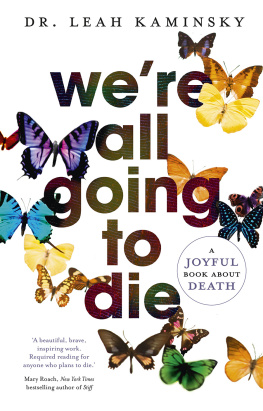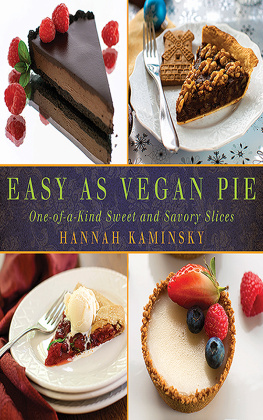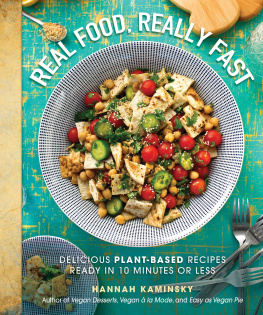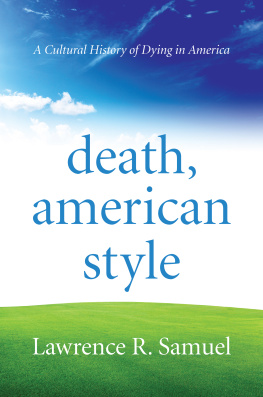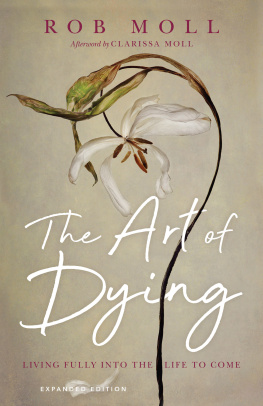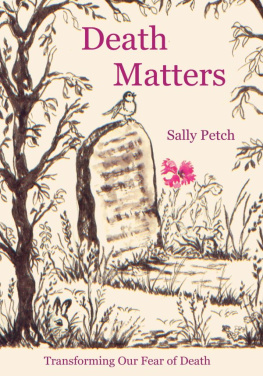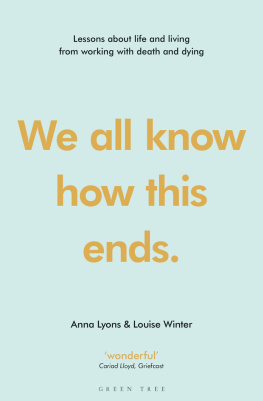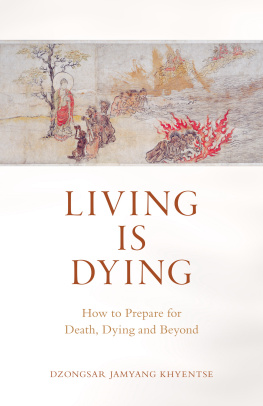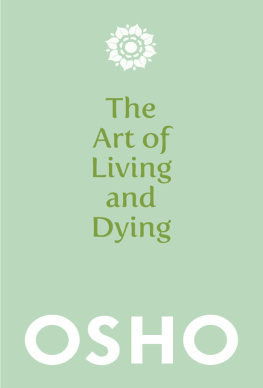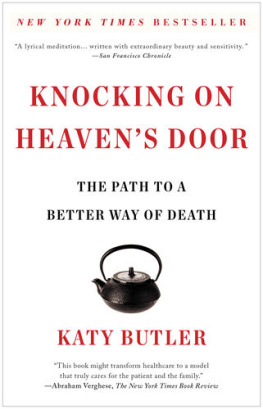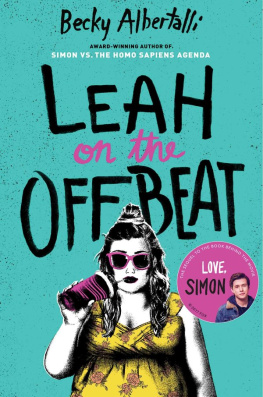For my children,
Alon, Ella and Maia,
and in memory of my parents.
I wished to live deliberately... and not, when I came to
die, discover that I had not lived... I wanted to live deep
and suck out all the marrow of life...
Henry David Thoreau
Contents
Guide
Ever since I can remember I have harboured a profound fear of death. Even as a child, something as small as a dying moth crawling around in circles, leaving powdery traces of itself on the bathroom floor, could set off a flood of tears. Skull motifs on T-shirts, tattoos and jewellery have always made me squirm. I am scared of becoming ill, of dying, ever anxious about my own safety as well as the wellbeing of my family and friends. So how on earth did I choose a career in medicine, where I am constantly surrounded by people facing the threat of death?
Until recent generations, death was very much a part of the fabric of life. Death avoidance, or the reluctance to engage in any thought or discussion around the subject, is a relatively new development in Western society. Nowadays, with the advent of mass immunisation, pharmaceuticals and other medical advances, we have almost forgotten that in the good old days disease was most often a death sentence. Less than a century ago, 10 per cent of infants didnt make it to their first birthday. Taking a stroll through an old section of a local cemetery is a sobering reminder of this, with many tiny graves lining the pathways. Religion once played a central role in providing a strong frame of reference for people to deal with death anxiety. The increasing secularisation of society sees many freefalling into a black hole of terror in the face of death, left trying to find another way to deal with this reality.
French historian Philippe Aris in his book Western Attitudes Toward Death from the Middles Ages to the Present refers to this recent change in attitude as the phenomenon of forbidden death. Death, so omnipresent in the past that it was familiar [has] become shameful... The displacement of the site of death during the turbulent decades between 1930 and 1950 saw an end to the tradition of dying at home. Hospitals became the mecca where people were brought to struggle against death; there they received the sort of care that family and friends could no longer provide. Shielded from the presence of death, Western society on the whole has developed a reluctance to talk about anything to do with dying. The embracing of youth culture has also helped lead to a marginalisation of the elderly. What was once looked upon as the wisdom of the elders has now become disdain for the crumbliesthey are, after all, an uncomfortable reminder of our own final destination.
Some nights I wake at 3 a.m. and watch the red numbers of the digital clock on my bedside table tick over. Each second is marked off by the thumping of my heart, as if its trying to win a race. In the darkness, I listen to my husband breathing quietly by my side. I am thinking of the years that have passed since we first shared a bed, planning a lifetime together, leaping excitedly into a future that seemed to roll a red carpet out before us. Each hour I lie awake, flipping from side to side like a fish dragged out of the safety of its watery home, I am an hour closer to my death.
Several years ago I decided to journey into the belly of the beast and explore this fear of death that I carry. I hoped that writing about the topic would help me find some inner peace in the face of mortalitys inexorable spectre. My dual role as a physician and writer has afforded me a privileged vantage point from which to explore the profound choices we make about how we live when we allow ourselves to think about death. I have talked to morticians, nonagenarians, children with terminal illnesses, gravediggers, artists and medical colleagues, spending my time discussing life with people who live at the very coalface of death. Drawing upon my years as a practising family doctor, being witness to so many moving first-hand stories and insights from my patients, I set out to ponder a question that has haunted human beings from the beginning of time: how can we accept our constant vulnerabilitythe truth that our days are numbered and our deaths inevitable? As Keanu Reeves once put it so theatrically: None of us are getting out of here alive.
* * *
My Uncle Max loved to dance. He was great at tango, foxtrot, swing, jive and polka, but he loved waltzing more than anything. I had just turned thirteen, but I can still remember Max on the night of my cousins wedding, sporting a tuxedo and bow tie, twirling Aunt Luba around the dance floor. She wore a sequinned gown, her hair pinned up into a blonde beehive, her diamante earrings swinging from side to side to the beat of Quando, quando, quando. Towards the end of the evening, after I had grown tired of folding my napkin over and over into every origami configuration I knew, Uncle Max shimmied over to the childrens table. He stood in front of me, bowed from the waist and held out his hand with a flourish, inviting me to join him on the dance floor. That was the night I learned to waltz.
After whispering something into the band leaders ear, Uncle Max lifted me up and spun me around to the first bars of Que sera sera, my legs flying in the air, his black bow tie tickling my nose. He sang along, with a raspy voice, about not knowing what the future holds. Then, lowering me down, he danced one-two-three across the shiny floor, taking huge steps that my small feet tried to keep up with. My heart raced as people gradually stepped aside to watch us waltzing together; cousin Sammy, Aunty Henia, my parents, the Wilde family from next door, Mr Silver the tailor with the gammy leg, all stood in a circle admiring us. Their faces became a blur as Uncle Max whizzed me around faster and faster. Que sera, sera, he sang as we waltzed together. And before I knew it, the magical dance was over.
A few months later Uncle Max died of throat cancer. I remember standing beside his coffin, listening to dirt hitting wood, a sense of dread rising up in me. Until then, the concept of death and dying hadnt really existed for me. It was hidden, hinted at but guarded in the whispered conversations of my parents. They had come to Australia as refugees from a war-ravaged Europe, where they had both lost family and friends. They tried hard to shield me from anything to do with death; I wasnt allowed a pet because they didnt want me to have to face a beloved animal dying one day. As a child, the closest I had ever come to witnessing a corpse was seeing the decomposing body of a crow once, lying by the side of the road.
I grew up in a leafy suburb of Melbourne in 1960s Australia, playing hopscotch and marbles, oblivious to my parents traumas and fears. Looking back on my childhood, I know now that despite their attempts to preserve my innocence, the dead always had a strong but furtive presence in our household. Losing my dear Uncle Max was my first tangible encounter with mortality.
When Uncle Max asked me to dance that night, he would already have known that he wasnt long for this world. After Maxs funeral, I remember writing down everything I would do if someone told me I had a few months left to live, creating my own version of a bucket list. Number One was to take a Womens Weekly World Discovery Tour, like the ones advertised in the magazines my mother always left open on the kitchen table. I remember thinking that I would not agree to die until I had visited every country in the world.
As a family doctor, I have heard many peoples bucket list wishes over the years. Some want rainbow-coloured hair, others to learn Swahili or take up the harp; the more adventurous dream of bungee jumping off a remote cliff in New Zealand. Whatever our objectives, the fact remains that we all fantasise about what we would do if we knew our time on this planet was limited. As if that wasnt always the case.

